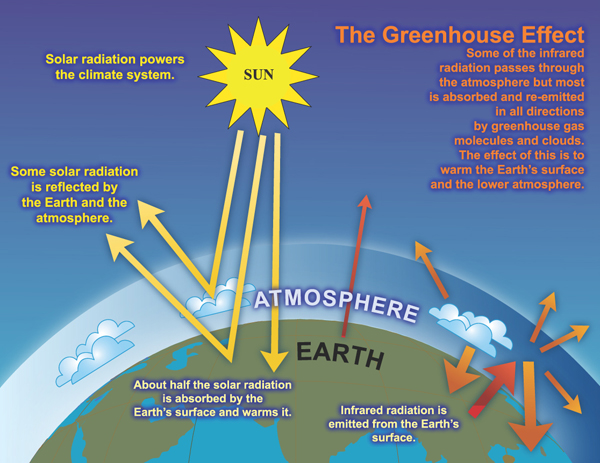Yesterday, we continued our focus on infographics about climate change by providing information (“the 411“) on important numbers you need to know – 350, 400 and 450. Today, we focus on the choices you have in your day-to-day life to reduce carbon emissions. It’s true that climate change is a big problem that will demand big solutions. But the day-to-day decisions you make at home, work, school, and play will also make a big difference.
First, you can start by understanding how climate change and global warming works. The more you understand the more you can help stop the spread of misinformation. You have likely heard of the greenhouse gas effect. This is what causes global warming. The greenhouse gas effect occurs when certain vapors and gases absorb the Earth’s heat energy, also known as infrared radiation, preventing it from being released back into space and making our planet warmer. The infographic below illustrates and further explains this process. This rise in global temperatures is what leads to changes in our climate and causes more extreme weather patterns such as a rise in sea levels, floods, drought, the loss of food, and more intense storms.

An infographic explaining the Greenhouse Gas Effect.
(Credit: World Wildlife Fund)
Next you can change your behaviors to reduce your CO2 emissions. Today, we offer you the Environmental Protection Agency’s Climate Change webpage for ways you can reduce your CO2 emissions. And, consistent with our theme of the month, you can find ways to do your part in the infographic below about the decisions you can make right in your life.

Credit: Enjoy Living Sustainably
Here are some easy ways, you can reduce your CO2 emissions every day:
Conserve water by:
- not letting your faucet run while shaving and brushing your teeth,
- washing only full loads of dishes and clothes, and
- fixing leaks in and around your home.
Use your car less when possible by:
- taking public transit or carpooling with someone to work,
- telecommuting, and
- riding your bike or walking to complete nearby errands.
Recycle, reduce, and reuse by:
- recycling paper and plastic goods such as newspapers and beverage containers and composting your food and yard waste,
- turning off lights in rooms you aren’t in and unplugging appliances when you aren’t using them, and
- buying clothing, books, furniture, and other house hold items second-hand.
There are many ways to be part of the solution. The infographic today puts them all in one place to be an easy reminder for you and your friends and family to reference.
We hope that you have enjoyed this infographic tour of climate change – from what causes it to what to do about it. We’ll be back next week with tips about this month’s theme of visual communications and the design process.
The Collaborative Services Blog Team

Recent Comments